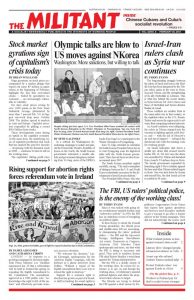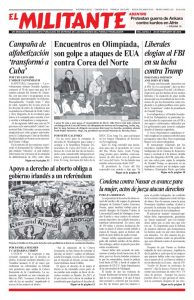Growing opposition to the Iranian capitalist rulers’ enforcement of restrictive dress codes for women has led to protests across the country, with women photographing themselves taking off their chador, or veil, in public. The press in the U.S. — from the left to right of bourgeois politics — have systematically pushed the false idea that the regime’s reactionary policies in Iran are the result of the massive popular uprising in 1979 that overthrew the dictatorial rule of the U.S.-backed shah, rather than a counterrevolutionary reversal.
Women’s rights widely expanded as part of that revolutionary upsurge. These gains were then attacked and restricted as the clerical regime pushed workers back and consolidated its counterrevolutionary rule in the early 1980s.
In response to growing opposition to their strictures on women, Brig. Gen. Hussein Rahimi, commander of Tehran’s police, announced Dec. 27 the city’s morality police would no longer automatically imprison women who refused to wear the hijab. They would be pushed to undergo “counseling.”
Since then press reports say dozens of women have defied authorities around the country by removing their hijabs in public. The protests came as working-class mobilizations broke out across the country against the regime’s wars in Syria, Iraq and Yemen and their effects on working people.
A Feb. 4 New York Times article headlined “Compulsory Veils? Half of Iranians Say No to Pillar of Revolution,” claimed that “the law regarding the scarf has been enforced since the 1979 Islamic Revolution.”
This is a lie. The mass revolutionary upsurge in 1979 was led by millions of working people, men and women, with or without hijabs. They fought for workers control in the factories, joined peasant struggles for land and demonstrated outside the U.S. Embassy.
The revolution opened political space to press forward the fight for women’s participation in all aspects of social and political life. Women stood for office in the shoras — factory committees — that fought to expand workers control of production. They demanded military training and to be able to participate in the war against the U.S.-backed Iraqi invasion of Iran in 1980.
When Ayatollah Ruhollah Khomeini announced March 7, 1979, that women government workers must “be clothed according to Islamic standards,” and wear the veil at work, the following day the world’s largest International Women’s Day march that year took place in Tehran. Thousands of high school students went on strike. When rightist thugs attacked some demonstrators, larger protest actions were organized, joined by many women wearing veils. On March 12, some 15,000 people marched in Tehran demanding, “To deny women freedom is to deny freedom to the rest of society.”
In the face of these mobilizations, Khomeini denounced the thug assaults on the women’s rights protests and backed down from his pronouncement.
The Iranian rulers weren’t successful in making their anti-women restrictions law until 1983, as the counterrevolution was consolidated. It was part of moves to stifle efforts by workers to organize independently of the bosses, prevent them from making encroachments on capitalist rule and pushing back gains made in 1979. They used gangs of thugs to break up workers’ organizations and protests, and imprisoned and executed political opponents. As part of this counterrevolution they organized “anti-vice” goon squads to confront women on the streets and compel them to wear the hijab.
But Iran’s capitalist rulers were never able to impose the kind of suffocating conditions on women that the Taliban inflicts in Afghanistan. Or that the Wahhabi monarchs imposed in Saudi Arabia — which they are now taking steps to loosen as they seek to modernize to better confront challenges from Tehran.
The widespread working-class discontent across Iran is fueled by political questions, especially the mounting toll of the Iranian rulers’ military efforts to expand their counterrevolutionary reach in the Mideast. As the rulers’ political and moral crisis unfolds the fight for women’s rights will be an important part of the struggle to forge the unity workers need to advance their interests.

